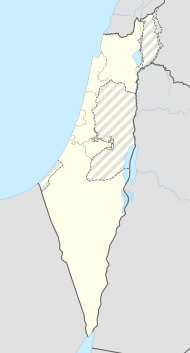Tuba zangarija
| Tuba zangarija | ||
|---|---|---|

|
||
| Basic data | ||
| hebrew : | טוּבָּא-זַנְגָרִיָה | |
| arabic : | طوبه زنغرية | |
| State : |
|
|
| District : | North | |
| Coordinates : | 32 ° 58 ' N , 35 ° 36' E | |
| Height : | 294 m | |
| Area : | 1.962 km² | |
| Residents : | 6667 (as of 2018) | |
| Population density : | 3,398 inhabitants per km² | |
| Community code : | 0962 | |
| Time zone : | UTC + 2 | |
| Community type: | Local association | |
| Mayor : | Zvika Fogel | |
| Website : | ||
|
|
||
Tuba-Zangarija (also Tuba az-Zanghariya ) ( Arabic طوبه زنغرية, Hebrew טוּבָּא-זַנְגָרִיָה) is a community inhabited by Bedouins from the 'Arab al-Heib tribe with the status of a local association in the northern district of Israel with 6667 inhabitants (as of 2018).
geography
Tuba-Zangarija is located at 250 meters above sea level near the Jordan in the Chula plain . It is located about 8.5 km east of Safed near Rosh Pina and the kibbutz Kfar Hanassi . The Golan Heights begin 2 kilometers east. The community consists of the parts Ein Tuba (tuba sources) and Al-Zanghariyya and covers an area of 2,962 dunams , about 2 square kilometers. Before the Arab-Israeli War of 1948 , the area of Al-Zanghariyya alone had an area of 27,918 dunams.
history
The Bedouin tribes of 'Arab Al-Zanghariyya and ' Arab Al-Heib lived with their flocks in tents by the Tuba fountain or in stone houses until 1903. The Bedouins of the Al-Heib tribe had long had good relations with the Jewish settlers who had settled in the outskirts of the Chula Plain since the 1880s. During the Arab uprising from 1936 to 1939 they helped the Jewish settlers in their defense efforts. In 1948 they formed an alliance with the Hagana to defend Upper Galilee against the invading Syrian forces. Some of them formed a special unit with the Palmach, the Pal-Heib .
On May 4, 1948, before Israel declared independence, the two Bedouin settlements were attacked and conquered by Operation Matateh (Operation Besen) as part of Operation Yiftach . Some of the residents of Al-Zanghariyya fled to the neighboring tuba, but most went to Syria. The abandoned buildings were blown up on June 17, 1948. Today are in this area of Moshav Elifelet and private Farm named Kare Desche.
Until the 1960s, the remaining Bedouins lived in tubas in their tents made of reed, but today their community is a village with stone houses, mosques, roads, and water and electricity supplies. In 1988 Tuba-Zangarija became a local association under Israeli municipal law.
2011 attack
On the night of October 3, 2011, there was an arson attack on the mosque of Tuba-Zangarija, which is counted among the price-tag attacks because of the slogans on the walls of the building . It is said to be revenge (the price) for a terrorist attack in Hebron in September 2011 that killed two Israelis. Official Israel was shocked that some of the community's residents are part of the Israel Defense Forces (IDF). President Shimon Peres and the chief rabbis of the two Jewish communities of Ashkenazim and Sephardim , Jona Metzger and Shlomo Amar , drove to the scene the day after the attack to express their regret over the incident.
literature
- Walid Khalidi : Why Did the Palestinians Leave? Middle East Forum, July 1959.
- Ilan Pappe : The Ethnic Cleansing of Palestine . Zweiausenundeins, Frankfurt am Main 2007, ISBN 978-3-86150-791-8 .
Individual evidence
- ↑ אוכלוסייה ביישובים 2018 (population of the settlements 2018). (XLSX; 0.13 MB) Israel Central Bureau of Statistics , August 25, 2019, accessed May 11, 2020 .
- ↑ Arsonists in their own ranks. In: FAZ . October 5, 2011.
